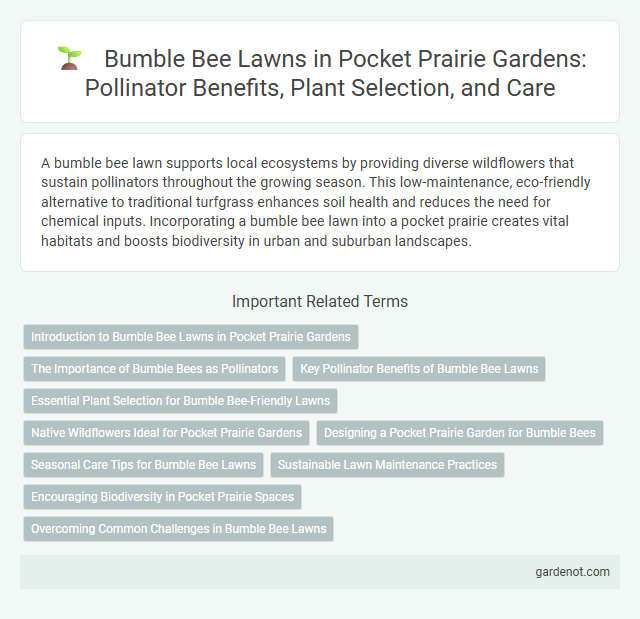A bumble bee lawn supports local ecosystems by providing diverse wildflowers that sustain pollinators throughout the growing season. This low-maintenance, eco-friendly alternative to traditional turfgrass enhances soil health and reduces the need for chemical inputs. Incorporating a bumble bee lawn into a pocket prairie creates vital habitats and boosts biodiversity in urban and suburban landscapes.
Introduction to Bumble Bee Lawns in Pocket Prairie Gardens
Bumble bee lawns in pocket prairie gardens offer a sustainable alternative to traditional turf by incorporating native wildflowers and grasses that support pollinator populations. This low-mow, biodiverse landscape enhances habitat for bumble bees, improving local ecosystem health and promoting pollination services. Establishing a bumble bee lawn involves selecting regionally adapted plant species that provide nectar and pollen throughout the growing season, fostering resilient pollinator communities.
The Importance of Bumble Bees as Pollinators
Bumble bees play a crucial role in pollinating a wide variety of native plants and crops, enhancing biodiversity and ecosystem health within pocket prairies. Their ability to buzz pollinate improves the reproduction of many wildflowers and agricultural plants, boosting seed and fruit production. Supporting bumble bee populations contributes to sustainable pollination services essential for maintaining resilient natural and cultivated environments.
Key Pollinator Benefits of Bumble Bee Lawns
Bumble bee lawns provide essential habitat and nourishment by incorporating a diverse mix of native flowering plants that bloom throughout the growing season. These lawns support bumble bee populations by offering continuous sources of nectar and pollen, which are vital for their colony development and pollination activities. By enhancing urban and suburban green spaces with bumble bee lawns, ecosystems experience increased biodiversity and improved pollination of nearby crops and wild plants.
Essential Plant Selection for Bumble Bee-Friendly Lawns
Selecting native wildflowers such as purple coneflower, black-eyed Susan, and creeping thyme enhances bumble bee-friendly lawns by providing vital nectar and pollen sources. Incorporating clover species like white and red clover improves soil nitrogen fixation while supporting bumble bee foraging. Avoiding conventional turf grass in favor of diverse, native plant communities promotes habitat resilience and sustains local bumble bee populations.
Native Wildflowers Ideal for Pocket Prairie Gardens
Bumble bee lawns featuring native wildflowers such as purple coneflower, black-eyed Susan, and little bluestem grass provide essential habitat and nectar sources for pollinators in pocket prairie gardens. These drought-tolerant, low-maintenance plants enhance biodiversity while supporting local ecosystems by attracting native bees, butterflies, and other beneficial insects. Incorporating native wildflowers in bumble bee lawns promotes resilience against invasive species and improves soil health through deep-rooted prairie plants.
Designing a Pocket Prairie Garden for Bumble Bees
Designing a pocket prairie garden for bumble bees involves selecting a diverse mix of native wildflowers, grasses, and legumes that provide continuous bloom from early spring through late fall, crucial for sustaining bumble bee populations. Incorporating plants such as purple coneflower (Echinacea purpurea), black-eyed Susan (Rudbeckia hirta), and wild bergamot (Monarda fistulosa) ensures abundant nectar and pollen sources, supporting healthy colony growth. Strategic placement of flowering plants in clusters and ensuring pesticide-free soil conditions enhance foraging efficiency and habitat suitability for various Bombus species.
Seasonal Care Tips for Bumble Bee Lawns
Bumble bee lawns thrive with seasonal care, including regular watering during dry periods and mowing to maintain a height of 3-4 inches, which encourages flowering and supports pollinators. In early spring, apply a light fertilizer rich in phosphorus to promote root development, while avoiding excessive nitrogen that can inhibit blooms. Fall preparation involves overseeding bare patches and removing debris to ensure a healthy, vibrant lawn that attracts and sustains bumble bee populations.
Sustainable Lawn Maintenance Practices
Bumble bee lawns support sustainable lawn maintenance by reducing the need for synthetic fertilizers and pesticides, thereby enhancing biodiversity and soil health. These lawns incorporate native flowering plants that provide essential forage for pollinators, promoting ecosystem resilience and reducing water consumption through drought-tolerant species. Sustainable management practices such as minimal mowing and organic weed control further strengthen the environmental benefits and long-term viability of bumble bee lawns.
Encouraging Biodiversity in Pocket Prairie Spaces
Bumble bee lawns in pocket prairie spaces provide vital foraging habitats by incorporating native wildflowers and diverse grasses that attract and support pollinators. These lawns enhance local biodiversity by offering continuous blooms throughout the growing season, promoting a balanced ecosystem and improving soil health. Integrating bumble bee lawns into pocket prairies fosters ecological resilience and supports the survival of essential pollinator species.
Overcoming Common Challenges in Bumble Bee Lawns
Bumble bee lawns face challenges such as soil compaction, insufficient floral diversity, and pesticide exposure that can hinder pollinator populations. Implementing organic soil aeration techniques and planting native wildflowers enhances habitat quality and nutrient availability. Avoiding chemical pesticides and practicing rotational mowing supports healthier bumble bee colonies and promotes sustainable lawn ecosystems.
Bumble bee lawn Infographic

 gardenot.com
gardenot.com